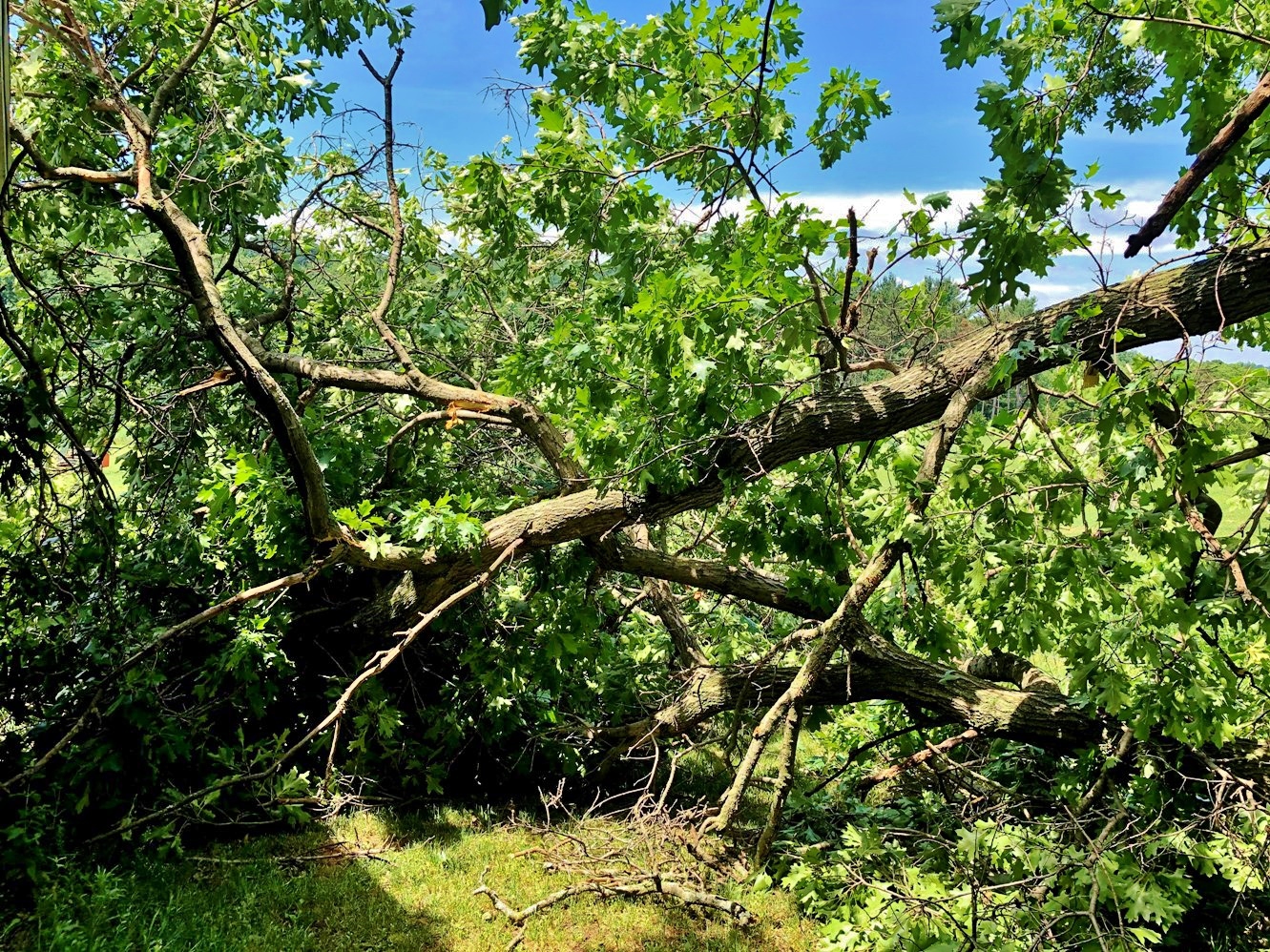Back Home by Chris Hardie
» Download this column as a Word document
» Download the photos that accompany this story
» Chris Hardie’s headshot
It was a peaceful Sunday afternoon on the farm the day after a much-needed late-June rain. Suddenly, the sleepy midday was shattered by two loud bangs.

The source of the noise? Two large limbs from an oak tree in our yard suddenly and violently plummeted to the ground. They narrowly missed a storage building, falling mainly between the building and a nearby fence.
With woods all around us, we’re accustomed to hearing trees fall — especially during severe-weather events like the devastating straight-line winds that ravaged the farm in 1998. But there was no gust of wind, no lightning strike and no tornado. And the tree was not dead and didn’t have any visual impairments.
Welcome to the mystery of sudden branch drop or summer limb drop, which is a real phenomenon that has only theories for its causes. It often happens with a large mature tree species like oak following a rainfall after a period of dry weather or drought, lasting longer than three to four weeks in the early afternoon in calm conditions.
All three of those conditions were in play with our limb failure.
The puzzle was first noted by California botanist Albert Kellogg in his 1882 book “Forest Trees of California,” according to Oregon company Urban Forest Professionals. Kellogg warned of redwood trees that burst with a loud explosion, as well as strong limbs that unexpectedly crash down with the fracture disclosing no weakness.
So what causes trees to explode? No one knows for sure, but arborists generally believe that it’s connected to humidity levels in the tree. Trees release water through evapotranspiration through their leaves. Stress from drought can cause an increase in ethylene-gas concentration, which when combined with reduced evapotranspiration weakens a limb.
Other causes could be injuries to the tree — especially freezing water in a branch fork, which can weaken limbs. That can happen especially when there’s a fissure. Others believe extreme moisture within the canopy adds excessive weight to the branches.
Perhaps an arborist could determine what caused our limb drop. There’s a split in the tree trunk above the location where the break happened, but the branch that broke off showed no sign of distress.
We were fortunate the branches fell where they did without any building damage. The chances of dropping those limbs in that same location with a chainsaw would have required some skillful cutting.
There will be less skillful cutting involved in the tree-branch cleanup, but at least we won’t need to replace a roof and no one was injured. It’s possible the tree may also need to come down; some of next year’s firewood will be cut closer to home.
Tick story leads to fallout, feedback
A few readers offered feedback and some sympathy concerning my recent column about having a tick removed from an extremely sensitive area.
Dorothy Leland, director of communications for LymeDisease.org, said, “Bummer about your experience with the tick. But what a great column you wrote about it!”
Leland then requested permission to republish the column as a guest blog on the organization’s website. So at least my misfortune helped create additional attention to Lyme — not that I needed the attention.
Another reader, Joanne, wrote, “Good morning. I read yesterday’s (La Crosse) Tribune this morning with my coffee … and I thank you for making me actually laugh out loud at 6 a.m. It is rare for me to actually laugh while reading, and I just kept laughing … sorry at the expense of your revelation. Just wanted you to know you helped start my day well.”
Gary Terbeest of La Crosse sent me a nice note recalling several of my columns through the years, calling them “witty, entertaining and often educational.”
Clearly, he has me confused with someone else. But he did offer some advice as well.
“I’m glad the doc got that tick out without resorting to the knife,” he wrote. “I encourage you to pick up a couple of new high-quality tweezers at your earliest opportunity. While you are at it, grab a couple of magnifying glasses too.”
Ken Wright of Caledonia, Minn., said his daughter’s family solved their tick problem with five chickens allowed to free-range during the day. They eat the ticks.
“I would strongly recommend getting a few hens to solve your tick problem,” he wrote. “What would you have to lose?”
Probably a few hens to coyotes or the neighbor’s dogs, but then again …
And finally, Steve Lovejoy, a former colleague of mine from back in my newspaper days, offered me some helpful advice.
“Fer gosh sakes, Chris, all you write lately are medical columns,” he wrote. “Stay out of the tall weeds and don’t go into the woods during rutting season.”
Easier said than done, Steve.
Chris Hardie spent more than 30 years as a reporter, editor



